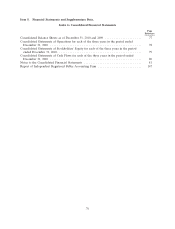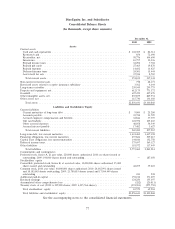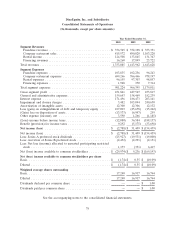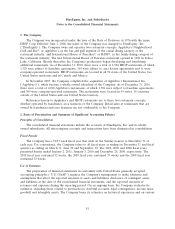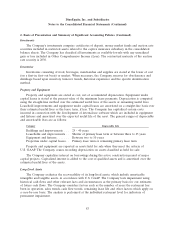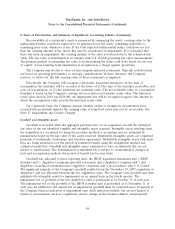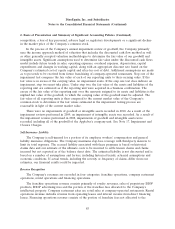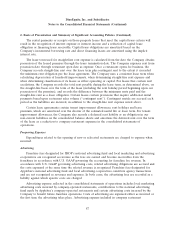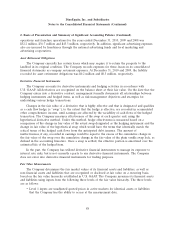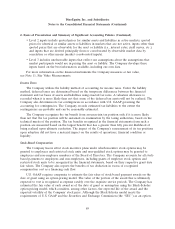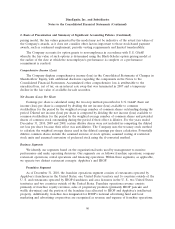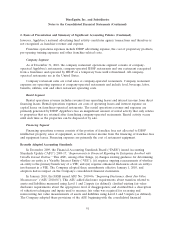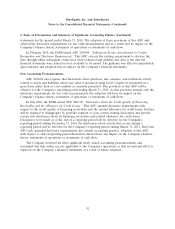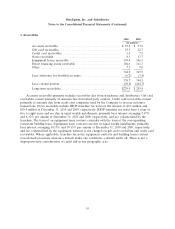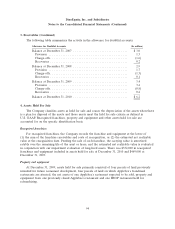IHOP 2010 Annual Report Download - page 100
Download and view the complete annual report
Please find page 100 of the 2010 IHOP annual report below. You can navigate through the pages in the report by either clicking on the pages listed below, or by using the keyword search tool below to find specific information within the annual report.DineEquity, Inc. and Subsidiaries
Notes to the Consolidated Financial Statements (Continued)
2. Basis of Presentation and Summary of Significant Accounting Policies (Continued)
Recoverability of a restaurant’s assets is measured by comparing the assets’ carrying value to the
undiscounted future cash flows expected to be generated over the assets’ remaining useful life or
remaining lease term, whichever is less. If the total expected undiscounted future cash flows are less
than the carrying amount of the assets, this may be an indicator of impairment. If it is decided that
there has been an impairment, the carrying amount of the asset is written down to the estimated fair
value. The fair value is determined in accordance with U.S. GAAP governing fair value measurements.
The primary method of estimating fair value is by discounting the future cash flows based on our cost
of capital. A loss resulting from impairment is recognized as a charge against operations.
The Company may decide to close certain company-operated restaurants. Typically such decisions
are based on operating performance or strategic considerations. In these instances, the Company
reserves, or writes off, the full carrying value of these restaurants as impaired.
Periodically, the Company will reacquire a previously franchised restaurant. At the time of
reacquisition, the franchise will be recorded at the lower of (1) the sum of the franchise receivables and
costs of reacquisition, or (2) the estimated net realizable value. The net realizable value of a reacquired
franchise is based on the Company’s average five-year historical franchise resale value. The historical
resale value used in 2010 was $256,000. An impairment loss will be recognized equal to the amount by
which the reacquisition value exceeds the historical resale value.
On a quarterly basis, the Company assesses whether events or changes in circumstances have
occurred that potentially indicate the carrying value of long-lived assets may not be recoverable. See
Note 17, Impairment and Closure Charges.
Goodwill and Intangible Assets
Goodwill is recorded when the aggregate purchase price of an acquisition exceeds the estimated
fair value of the net identified tangible and intangible assets acquired. Intangible assets resulting from
the acquisition are accounted for using the purchase method of accounting and are estimated by
management based on the fair value of the assets received. Identifiable intangible assets are comprised
primarily of trademarks, tradenames and franchise agreements. Identifiable intangible assets with finite
lives are being amortized over the period of estimated benefit using the straight-line method and
estimated useful lives. Goodwill and intangible assets considered to have an indefinite life are not
subject to amortization. The determination of indefinite life is subject to reassessment if changes in
facts and circumstances indicate the period of benefit has become finite.
Goodwill was allocated to three reporting units, the IHOP franchised restaurants unit (‘‘IHOP
franchise unit’’), Applebee’s company-operated restaurants unit (‘‘Applebee’s company unit’’) and
Applebee’s franchised restaurants unit (‘‘Applebee’s franchise unit’’) in accordance with U.S. GAAP.
The significant majority of the Company’s goodwill resulted from the November 29, 2007 acquisition of
Applebee’s and was allocated between the two Applebee’s units. The Company tests goodwill and other
indefinite life intangible assets for impairment on an annual basis in the fourth quarter. The
impairment test of goodwill of the two Applebee’s units is performed as of October 31 of each year.
The impairment test of the goodwill of the IHOP franchise unit is performed as of December 31 of
each year. In addition to the annual test of impairment, goodwill must be evaluated more frequently if
the Company believes indicators of impairment exist. Such indicators include, but are not limited to,
events or circumstances such as a significant adverse change in the business climate, unanticipated
84




